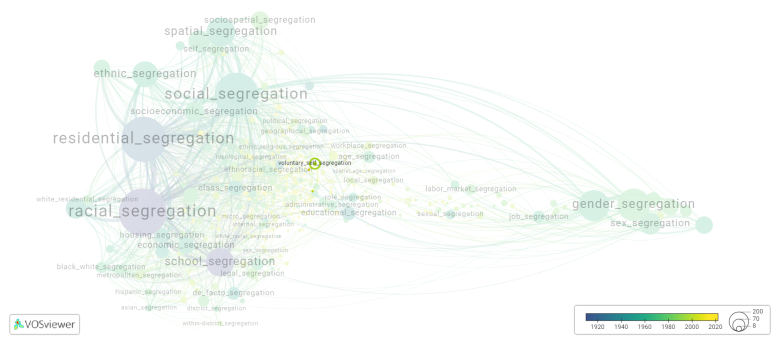Voluntary self segregation: Difference between revisions
(Creating page) |
(Creating page) |
||
| (5 intermediate revisions by the same user not shown) | |||
| Line 16: | Line 16: | ||
It is essential to strike a balance between voluntary self-segregation and fostering inclusive communities that respect and celebrate diversity. Encouraging open dialogue, promoting understanding, and creating spaces that accommodate different perspectives can help bridge gaps and promote social integration. | It is essential to strike a balance between voluntary self-segregation and fostering inclusive communities that respect and celebrate diversity. Encouraging open dialogue, promoting understanding, and creating spaces that accommodate different perspectives can help bridge gaps and promote social integration. | ||
==See also== | ==See also== | ||
==Related segregation forms== | |||
Voluntary self segregation is frequently discussed in the literature with the following segregation forms: | |||
[[social segregation]], [[charter school segregation]], [[spatial segregation]], [[american spatial segregation]] | |||
[[File:voluntary_self_segregation.png|780x780px]] | |||
This visualization is based on the study [[Segregation_Wiki:About| The Multidisciplinary Landscape of Segregation Research]]. | |||
For the complete network of interrelated segregation forms, please refer to: | |||
* [https://tinyurl.com/2235lkhw First year of publication] | |||
* [https://tinyurl.com/2d8wg5n3 Louvain clusters] | |||
* [https://tinyurl.com/223udk5r Betweenness centrality] | |||
* [https://tinyurl.com/244d8unz Disciplines in which segregation forms first emerged (Scopus database).] | |||
==References== | ==References== | ||
==Notes== | ==Notes== | ||
<references /> | <references /> | ||
{{NoteAI}} | {{NoteAI}} | ||
==Voluntary | ==Voluntary self segregation appears in the following literature== | ||
Teixeira C. (2006). A comparative study of Portuguese homebuyers' suburbanization in the Toronto and Montreal areas. ''Espace-Populations-Societes'', 121-135. Universite des Sciences et Technologiques de Lille.https://doi.org/10.4000/eps.1025 | Teixeira C. (2006). A comparative study of Portuguese homebuyers' suburbanization in the Toronto and Montreal areas. ''Espace-Populations-Societes'', 121-135. Universite des Sciences et Technologiques de Lille.https://doi.org/10.4000/eps.1025 | ||
| Line 26: | Line 43: | ||
Bruner D.Y. (2008). Aspiring and practicing leaders addressing issues of diversity and social justice. ''Race Ethnicity and Education'', ''11''(4), 483-500. https://doi.org/10.1080/13613320802479059 | Bruner D.Y. (2008). Aspiring and practicing leaders addressing issues of diversity and social justice. ''Race Ethnicity and Education'', ''11''(4), 483-500. https://doi.org/10.1080/13613320802479059 | ||
Wilson T.S. ( | Wilson T.S. (201). Civic Fragmentation Or Voluntary Association? Habermas, Fraser, And Charter School Segregation. ''Educational Theory'', ''60''(6), 643-664. https://doi.org/10.1111/j.1741-5446.2010.00382.x | ||
Stern S. (2021). "Separate, therefore equal": American spatial segregation from Jim Crow to Kiryas Joel. ''RSF'', ''7''(1), 67-90. Russell Sage Foundation.https://doi.org/10.7758/RSF.2021.7.1.05 | Stern S. (2021). "Separate, therefore equal": American spatial segregation from Jim Crow to Kiryas Joel. ''RSF'', ''7''(1), 67-90. Russell Sage Foundation.https://doi.org/10.7758/RSF.2021.7.1.05 | ||
Latest revision as of 07:17, 16 October 2024
Date and country of first publication[1][edit | edit source]
2006
Canada
Definition[edit | edit source]
Voluntary self-segregation refers to individuals or groups consciously choosing to separate themselves from others based on their own preferences, beliefs, or identities. It is a phenomenon commonly observed in various social contexts, such as residential neighborhoods, schools, workplaces, and social gatherings.
In some cases, voluntary self-segregation may occur due to cultural, religious, or ethnic differences. People may feel more comfortable being surrounded by others who share similar backgrounds, values, or experiences. This can provide a sense of belonging, solidarity, and familiarity.
Voluntary self-segregation can also happen based on socioeconomic factors. People may opt to live, work, or socialize with others of similar economic or educational backgrounds to connect and collaborate with individuals who might have similar opportunities, goals, or interests.
Another dimension of self-segregation revolves around political or ideological beliefs. People may voluntarily segregate themselves from those with opposing political views or affiliations as a way to avoid conflict or maintain a sense of unity within their preferred groups.
While voluntary self-segregation is a personal choice, it can have both positive and negative consequences. On one hand, it can foster a sense of community, support, and belonging among individuals of similar backgrounds or interests. On the other hand, it may contribute to social fragmentation, reinforce stereotypes, limit diversity of perspectives, and lead to further polarization in society.
It is essential to strike a balance between voluntary self-segregation and fostering inclusive communities that respect and celebrate diversity. Encouraging open dialogue, promoting understanding, and creating spaces that accommodate different perspectives can help bridge gaps and promote social integration.
See also[edit | edit source]
Related segregation forms[edit | edit source]
Voluntary self segregation is frequently discussed in the literature with the following segregation forms:
social segregation, charter school segregation, spatial segregation, american spatial segregation

This visualization is based on the study The Multidisciplinary Landscape of Segregation Research.
For the complete network of interrelated segregation forms, please refer to:
References[edit | edit source]
Notes[edit | edit source]
- ↑ Date and country of first publication as informed by the Scopus database (December 2023).
At its current state, this definition has been generated by a Large Language Model (LLM) so far without review by an independent researcher or a member of the curating team of segregation experts that keep the Segregation Wiki online. While we strive for accuracy, we cannot guarantee its reliability, completeness and timeliness. Please use this content with caution and verify information as needed. Also, feel free to improve on the definition as you see fit, including the use of references and other informational resources. We value your input in enhancing the quality and accuracy of the definitions of segregation forms collectively offered in the Segregation Wiki ©.
Voluntary self segregation appears in the following literature[edit | edit source]
Teixeira C. (2006). A comparative study of Portuguese homebuyers' suburbanization in the Toronto and Montreal areas. Espace-Populations-Societes, 121-135. Universite des Sciences et Technologiques de Lille.https://doi.org/10.4000/eps.1025
Bruner D.Y. (2008). Aspiring and practicing leaders addressing issues of diversity and social justice. Race Ethnicity and Education, 11(4), 483-500. https://doi.org/10.1080/13613320802479059
Wilson T.S. (201). Civic Fragmentation Or Voluntary Association? Habermas, Fraser, And Charter School Segregation. Educational Theory, 60(6), 643-664. https://doi.org/10.1111/j.1741-5446.2010.00382.x
Stern S. (2021). "Separate, therefore equal": American spatial segregation from Jim Crow to Kiryas Joel. RSF, 7(1), 67-90. Russell Sage Foundation.https://doi.org/10.7758/RSF.2021.7.1.05
